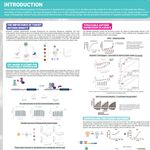Product Specialist for Microscopy Cameras at Andor Technology.
BIOGRAPHY

Speakers
-
Jean A. Castillo-Badillo, PhD
N. Gautam lab. - Department of Anesthesiology, Washington University School of Medicine in St. Louis, MOBIOGRAPHY -
Claudia Florindo, PhD
Product Specialist - Life Sciences, Andor TechnologyBIOGRAPHY
Event Date & Time
DATE: April 30, 2020
TIME: 8AM PT, 11AM ET, 4PM BST, 5PM CET
Abstract
Cytokinesis is the physical separation of two cells that occurs after the completion of mitosis. The mechanism underlying it is very complex. Until recently, the processes that lead to cleavage furrow formation and the extensive membrane remodelling that culminates in cytokinesis were unknown. This was due to the inexistence of methods to rapidly induce cytokinetic processes at will while simultaneously imaging membrane dynamics with high spatiotemporal precision.
In this webinar, we will present how we used a combination of optical techniques such as subcellular optogenetics, FRAP, TIRF, confocal imaging (Dragonfly) and SRRF-stream imaging to uncover the membrane dynamics during the final steps of cytokinesis. By optically activating the small GTPase RhoA in the middle of a cell, we were able to induce cleavage furrow formation, and continued activation resulting in elongation of the furrow to form a structure resembling the intercellular bridge. Real-time confocal imaging showed that furrow formation is mediated by actomyosin contractility, plasma membrane flow to the furrow, localized decrease in membrane tension, and increased endocytosis in the furrow. Furthermore, FRAP experiments showed exocytosis in the intercellular bridge-like structure. TIRF combined with SRRF-stream imaging revealed a second exocytosis mechanism involving incorporation of membrane lipids from vesicles into the plasma membrane at the front edge of the nascent daughter cell. These results allowed us to propose a model in which spatially separated but coordinated plasma membrane depletion and addition mediate membrane remodelling during cytokinetic processes.
In this webinar, the following questions will be addressed:
- What are the membrane remodelling events that occur during cleavage furrow formation?
- What is SRRF-Stream?
- How can I to use optogenetic tools to analyse biological events?
Learning Objectives:
- Understand the role of vesicular trafficking in the membrane remodelling process during cleavage furrow formation.
- Discuss the advantages of using spinning disk confocal and optogenetic tools when researching dynamic events.
- Identify different microscopy techniques such as TIRF and FRAP, SRRF-stream, and their applications.
Webinars will be available for unlimited on-demand viewing after live event.
LabRoots is approved as a provider of continuing education programs in the clinical laboratory sciences by the ASCLS P.A.C.E. ® Program. By attending this webinar, you can earn 1 Continuing Education credit once you have viewed the webinar in its entirety.
You May Also Like
DEC 10, 2024 | 9:00 AM
To-date, proteomic analysis has been severely limited in scale and resolution. Analyzing protein samples using an intact, single-molecule approach holds th...
APR 21, 2025 | 1:00 PM
C.E. CREDITS
Routine coagulation assays are widely performed in laboratories and provide valuable information to the patient’s overall clinical picture. It’s important for laboratorians to kn...
Speaker:
Malissa S Norfolk, MBA, PMP, MLS(ASCP)ᶜᵐSHᶜᵐ
FEB 25, 2025 | 1:00 PM
C.E. CREDITS
Quality efforts in the clinical laboratory are always under the microscope- a hyper-focus for laboratorians from start to finish. Recognizing the external factors that affect hemostasis test...
Speaker:
Rae Kerlin, BS, MLS (ASCP), NCA
OCT 02, 2024 | 7:30 AM
De novo gene synthesis and protein expression are established technologies that can give access to nearly any target DNA or protein sequence, allowing for engineering of biologics. In this p...
Speaker:
Claudia Chiocchini
Presented at: Cancer Research & Oncology Virtual Event Series 2024
Sponsored By: Thermo Fisher Scientific
Sponsored By: Thermo Fisher Scientific
MAR 19, 2025 | 11:30 AM
Join this year's poster presenters in the Poster Hall during the Poster Networking Hour, Wednesday, March 5th, from 10:00 –11:00 AM PDT , to chat...
Loading Comments...
Please update your information
Certificate of Attendance
Thank you for choosing Labroots. Please note that a Certificate of Attendance does NOT count towards Continuing Education Credits.
DOWNLOAD CERTIFICATE
DOWNLOAD CERTIFICATE
You must watch the entire webinar to receive your certificate of attendance.
You must attend the event before receiving your certificate of attendance.
You must register for the event first.
Certificate is no longer available for this event.
You must be logged in to retrieve your certificate.







